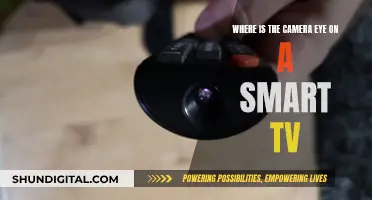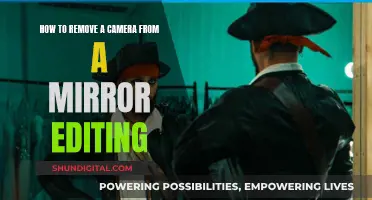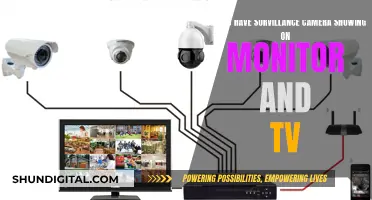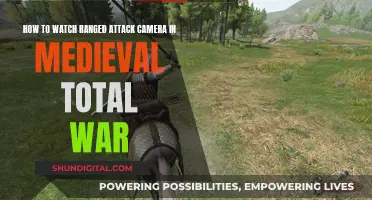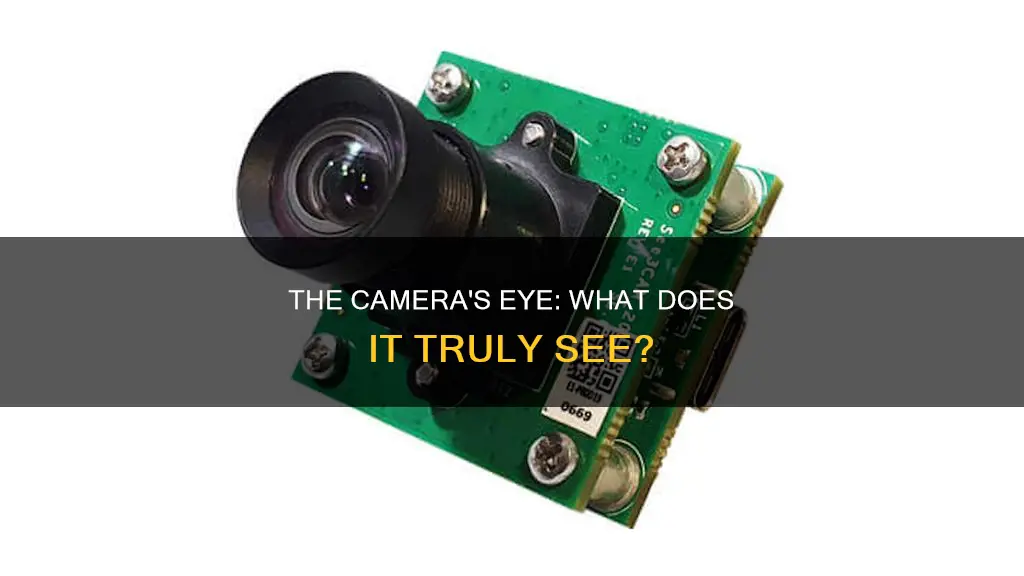
The human eye and the camera lens see the world differently. While the eye sees the world in video format, cameras capture still images, freezing motion in a way that the human eye cannot. Cameras can also see very faint light, use a very narrow or wide field of view, and view the world from cramped or dangerous places. Understanding how a camera works and how it differs from the human eye can help photographers take better pictures.
| Characteristics | Values |
|---|---|
| Records light differently | Cameras record light in a different way to the human eye and brain |
| Two-dimensional images | Cameras record the world in 2D, whereas humans have stereoscopic vision |
| Selective vision | The human brain ignores distractions, whereas a camera records everything |
| Focus | The human eye can focus on something very close, but a camera can blur the background behind a subject |
| Motion | The human eye cannot freeze motion, but a camera can |
| Perspective | Wide-angle lenses make objects seem further away, whereas telephoto lenses make them seem closer |
| Field of view | Telephoto lenses allow close-ups of faraway subjects, which the human eye cannot achieve |
| Light sensitivity | Cameras are more sensitive to colour in low light than the human eye |
| Long exposure | Long exposures can bring out more detail in the sky than the human eye can perceive |
What You'll Learn

Cameras can freeze motion
To achieve this, it is recommended to select a shutter priority mode, which allows the photographer to set a minimum shutter speed, leaving the camera to select the aperture and ISO accordingly. This is a semi-automatic mode, which is useful when photographing moving subjects, as it saves time making manual adjustments.
In addition to shutter speed, other settings can also impact the ability to freeze motion. For instance, a higher ISO can enable a faster shutter speed, although this may negatively impact the sharpness of the image. A smaller aperture can also help to capture the whole subject in focus during movement, but this will also result in a slower shutter speed.
By mastering these techniques and making adjustments according to the specific scenario, photographers can effectively freeze motion and capture sharp images of moving subjects.
Watching Camera Footage on PC: Easy Steps to Follow
You may want to see also

Cameras can see a wider field of view
The human eye cannot achieve a very wide field of view. A fisheye lens gives you an extremely wide field of view. Some even offer over 180 degrees of vision, meaning they can see behind themselves! The view is also distorted, so items in the centre of the frame appear larger than those near the edge.
With our eyes, we have neither such a large field of view nor such strong distortion. Fisheye lenses are very good for giving a view of the world quite different from what we see. Note that because of the wide field of view, you need to get quite close to your subject for maximum effect.
Wide-angle lenses can capture a broad landscape, but they can also be helpful in showing your subject (flower, animal, etc.) embedded within its surroundings.
Is Your Smart TV Watching You?
You may want to see also

Cameras can see very faint light
The human eye and a camera are very similar in their design and functioning, but the camera beats the eye when it comes to seeing the unseen. There are faint stars in the night sky that are invisible to the naked eye, but when you point a camera towards the same area and take a long exposure shot, you will see many more stars.
The main reason for this is exposure time. It is a measure of how long the shutter of the camera is exposed to light. In the case of our eyes, the exposure time is the time for which our retina is exposed to light without being 'refreshed'. Cameras have the feature of increasing the exposure time to hours, thus making them better at capturing faint stars and objects.
CCDs (charge-coupled devices) in cameras are highly sensitive to light, capturing 60-70% of photons, and the best ones exceed 90% sensitivity. This enables the detection of objects much fainter than what the human eye can perceive. CCDs can efficiently count photons in millions of pixels (megapixels), providing more accurate measurements and digital output that can be immediately analysed by computers.
Additionally, cameras have larger detectors, more pixels, and larger lenses than the human eye.
Smart TV Spy Cameras: Fact or Fiction?
You may want to see also

Cameras can see in black and white
In such situations, the camera's infrared lights and sensors are activated. The camera uses infrared light to illuminate its field of view, and this light falls outside the visible spectrum, beyond what we perceive as red. As a result, the camera sensor can only measure the brightness of the infrared light reflecting off objects, with brighter lights appearing white and dimmer lights appearing as shades of grey.
Additionally, some cameras, such as security cameras, are equipped with infrared sensors and lights that specifically enable them to capture black-and-white footage in low-light scenarios, such as at night or in a dark room. This feature can be toggled on and off, and when turned on, the camera will display a series of infrared LEDs glowing red to indicate that it is in infrared mode.
It is worth noting that even humans see mostly in black and white in very dark conditions. This is because our eyes have separate black-and-white-sensitive cells (rods) that function in low-light environments.
Another reason for a camera displaying in black and white could be a technical glitch. For instance, if the camera's infrared sensor gets stuck in the "on" position due to a glitch, it may continue to capture black-and-white images even when there is ample light. Performing a power cycle or checking the camera lens, sensor, cable, and power source for any issues can help resolve this problem.
Capturing a Solar Eclipse: Mirrorless Magic
You may want to see also

Cameras can see small details
Even everyday objects can look very different when captured at the macro level, opening up image opportunities you may not have considered before. For example, you can count the hairs on a spider's leg or the scales on a butterfly's wing.
The focal length is the most important factor in determining how far your security camera can see. The larger the focal length, the narrower the field of view and the larger the objects seem.
The field of view is very important for surveillance camera projects as it describes which part of the scene you can see. The wider the field of view, the more you can see of your scene, but fewer details are available as objects appear smaller and farther away from the camera.
High-resolution security cameras can increase their ability to deliver usable images and videos from a distance. For instance, 4MP or 5MP cameras can provide surveillance videos with clear and vivid details, which is what you want in a security camera.
The quality of your security camera also matters when determining the range of outdoor security cameras. Top security camera brands are more dependable when it comes to reliability, durability, and quality.
Is Your TV Spying on You? Built-In Cameras and Your Privacy
You may want to see also
Frequently asked questions
The way a camera works is quite different from the human eye. While there is nothing wrong with trying to capture what you saw, you can also use your camera to capture what you can't see.
You can use your camera to freeze motion, record very faint light, use a very wide or very narrow field of view, and view very small details.
Our vision is stereoscopic, meaning we have two eyes that look at things from slightly different angles. Cameras, on the other hand, see through a single lens and record the world in two-dimensional images.
Understanding how your camera sees will help you guide the viewer to look at what you deem important in the photo. You can do this by being selective and excluding any distractions in the background.


